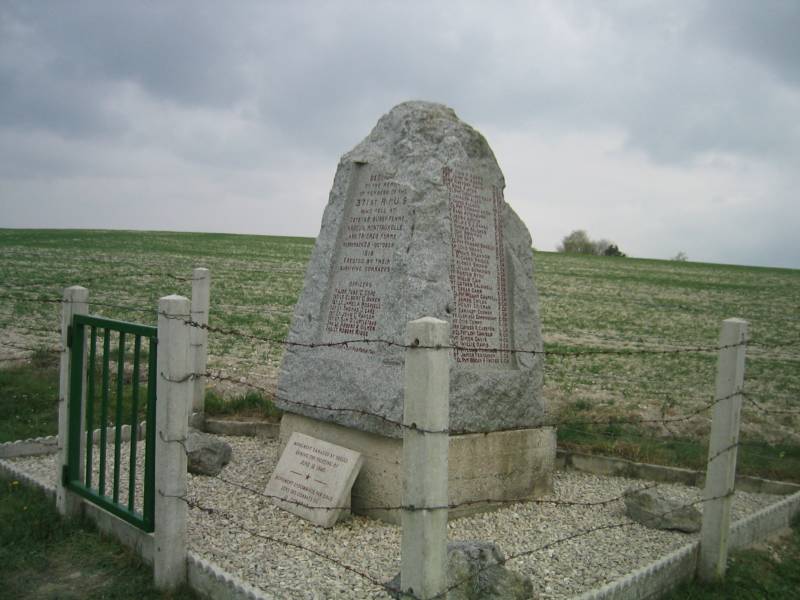371st Regiment World War I History
The 371st Infantry Regiment 93rd Division (Colored) arrived in France on 23 April 1918. Army commanders decided that the French army could better integrate the unit, and it was reorganized as a French unit. After training in the new French equipment and tactics, on 12 June 1918 the 371st went into the trenches as part of the veteran 157th “Red Hand” division. The 371st remained in the line for over three months, holding first the Avocourt and later the Verrières subsectors northwest of Verdun.
The regiment was then taken out of the line and thrown into the great September 1918 offensive in the Champagne. It took Côte 188, Bussy Ferme, Ardeuil, Montfauxelles, and Trieres Ferme near Monthois. The regiment captured many German prisoners, 47 machine guns, 8 trench engines, three 77mm. field pieces, a munitions depot, many railroad cars, and enormous quantities of lumber, hay and other supplies. It shot down three German airplanes by rifle and machine-gun fire during the advance. During the fighting between 28 September and 6 October 1918 its losses, which were mostly in the first three days, were 1,065 out of 2,384 actually engaged. The regiment was one of the most forward units of the attacking army in this great battle.
After the war, an officer of the 371st Regiment stated, “The French people could not grasp the idea of social discrimination on account of color. They said the colored men were soldiers, wearing the American uniform, and fighting in the common cause, and they could not see why they should be discriminated against. They received the men in their churches and homes.”
For its extraordinary service in the Champagne offensive, the entire regiment was awarded the Croix de Guerre with Palm. In addition, three of the officers of the 371st were awarded the French Legion of Honor, 123 men won the Croix de Guerre and 26 earned the Distinguished Service Cross. Corporal Freddie Stowers won the Medal of Honor.
The monument to the 371st Regiment located near the French towns of Ardeuil and Séchault. The top of the monument was damaged when it was hit by an artillery round during World War II.
371ème Régiment d'Infanterie (d’hommes de couleur)
Le 371ème Régiment d'Infanterie (d’hommes de couleur) de la 93ème division arriva en France le 23 avril 1918. Les commandants d'armée décidèrent que l'armée française pourrait mieux intégrer l'unité, et elle fut réorganisée comme unité française. Après une formation au nouvel équipement français et à la nouvelle tactique française, le 12 juin 1918 le 371ème entra dans les tranchées en tant qu'élément de la division "Main Rouge" de vétérans du 157ème. Le 371ème resta en ligne pendant plus de trois mois, tenant d'abord Avocourt et plus tard les sous-secteurs de Verrières au Nord-Ouest de Verdun.
Le régiment fut alors retiré de la ligne et jeté dans la grande offensive de septembre 1918, en Champagne. Il prit la Côte 188, Bussy Ferme, Ardeuil, Montfauxelles, et la Ferme de Trières près de Monthois. Le regiment captura beaucoup de prisonniers allemands, 47 mitrailleuses, 8 trancheuses, 3 pièces d’artillerie de 77mm., un dépôt de munitions, de nombreuses voitures de chemin de fer, et d'énormes quantités de bois de charpente, de foin et autres approvisionnements. Il abattit trois avions allemands sous le feu de fusil et de mitrailleuses pendant l'avancée. Pendant le combat, du 28 septembre au 6 octobre 1918, ses pertes, qui eurent lieu pour la plupart pendant les trois premiers jours, étaient de 1 065 sur 2 384 hommes réellement engagés. Le régiment était une des unités les plus avancées de l'armée attaquante dans cette grande bataille.
Après la guerre, un officier du 371ème régiment indiqua, "Les français ne pouvaient pas comprendre la discrimination sociale par la couleur. Ils disaient que les hommes de couleur étaient des soldats, portant l'uniforme américain, et combattant pour une cause commune, et ils ne pouvaient pas voir pourquoi ils devaient être discriminés. Les Français ont reçu les hommes dans leurs églises et dans leurs maisons."
Pour son extraordinaire service dans l'offensive de Champagne, le régiment entier reçut la Croix de Guerre avec palme. En outre, trois des officiers du 371ème reçurent la Légion d'Honneur française, 123 hommes furent décorés de la Croix de Guerre et 26 hommes de la Distinguished Service Cross (Croix Distinguée de Service - américaine). Le Caporal Freddie Stowers fut décoré de la Medal of Honor (Médaille d'Honneur - américaine).

